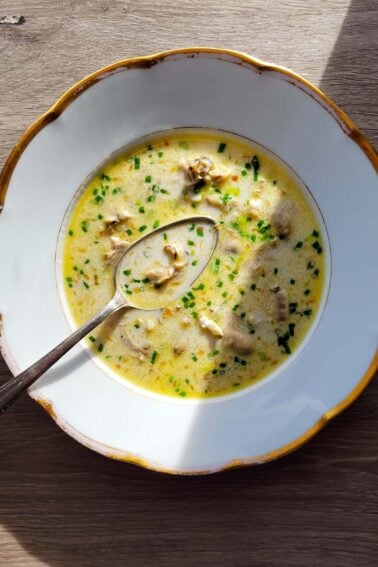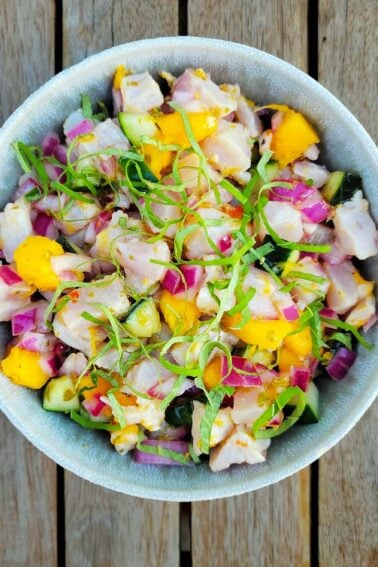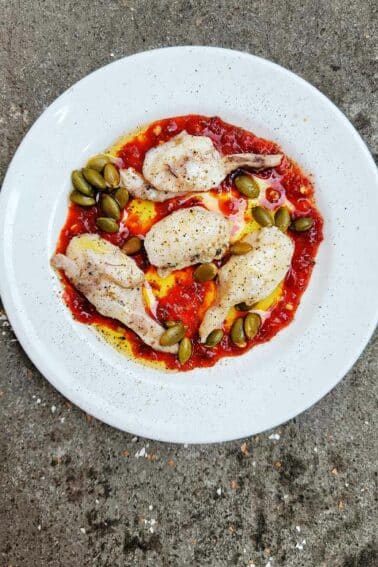As an Amazon Associate I earn from qualifying purchases.
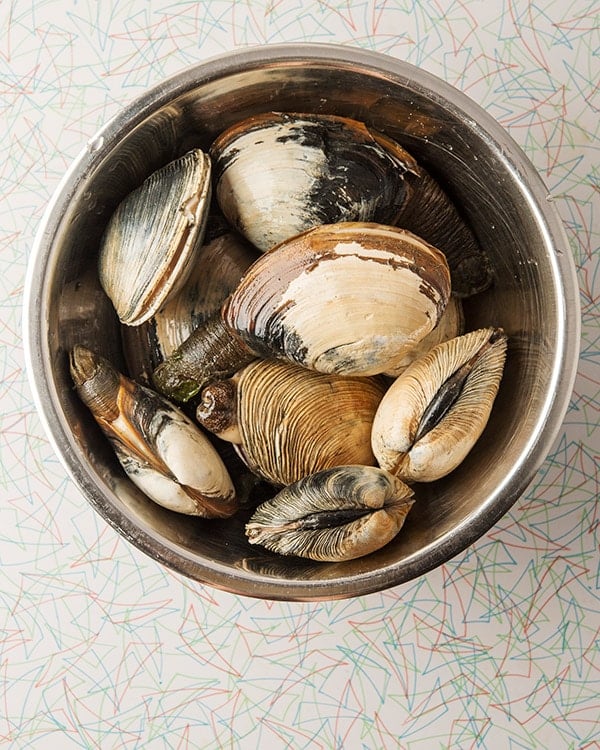
Clammers here on the Pacific Coast have heftier bivalves to contend with than the familiar quahogs, steamers and surf clams of the Atlantic.
We have an entire family of what are collectively called “gaper” clams, so called because there is so much clam to them their shells cannot fully close. The king of all these are the Pacific Northwest’s geoduck (and it’s New Zealand cousin the Panopea zelandica), but more common are the Washington clam (Saxidomus gigantea) and the horseneck clams, Tresus capax and T. nuttallii.
All can be, well, daunting when you wrangle them out of the mud and sand. They’re big, heavy, gooey… and there’s that well-endowed siphon of theirs, too. The very idea of eating one on the half shell makes me retch. And frying them is out of the question — at least whole. So what to do?
Here’s how to clean gaper clams to get them ready to eat, and at the end of this post I have a video I shot with my friends over at Original Fare on how to clean gaper clams that should cement in your mind these instructions.
First, you need to purge your clams. Read this article on how to do that.
When you are ready to do the cleaning, find a short, sharp knife like a paring knife or pocketknife. Get a big bowl to work over, because you want to capture all that wonderful clam juice. Be near a sink and running water.
Understand that a gaper’s shell is held tight by the same two “scallop” muscles all tasty bivalves use. You want to slip your knife into the shell above the siphon and run it along the inside of the top shell, slicing free the first “scallop” muscle and all the various bits. You can now open the shell completely.
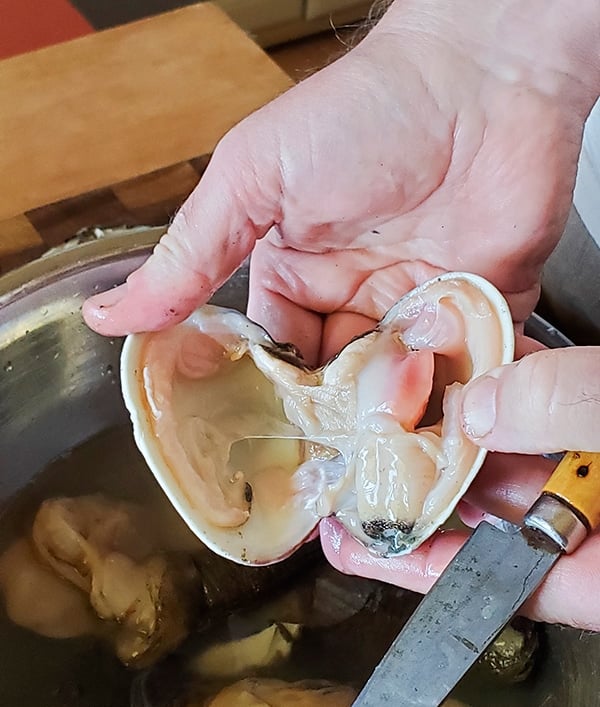
Yummy, eh? We’ll get to the anatomy of a clam in a bit. Now run your knife the same way, underneath the clam this time, to free it from the bottom shell. Drop it into the bowl with all the clam juice. Repeat until you have all the clams out of their shells. I discard the horseneck clam shells, but clean and keep the shells from large Washington clams; they make excellent dishes for stuffed clams.
With a bowl of gooey clam bits floating in salty clam juice staring at you, now what? First, remove all the horseneck (or geoduck) siphons from the rest of the clams. Cut just the siphon off, leaving the rest in one piece. Set the siphons aside. The siphons of Washington clams can be left on, as they don’t have the same gnarly skin on them.
Separate the clam juice from the clam meats. I do this by pouring the juice through a strainer that has a paper towel set inside it into another bowl. This is vital because whatever grit is left after purging will settle in the bottom of your bowl. Grit is the enemy. Keep this juice (it freezes well) for seafood soups and other recipes. I also freeze my clam meats submerged in the clam juice.
This is what the shucked clams look like. Washington clam on the left, horseneck on the right.
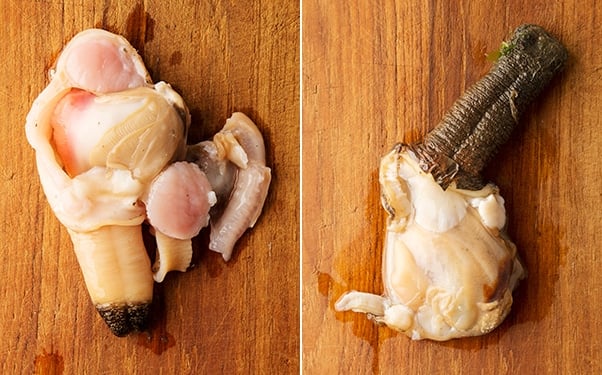
In general, you will want to keep the siphon, the two little “scallop” muscles, the dense, muscular foot, and the frilly, firm gills. You separate all this from the belly, and it will look like this.
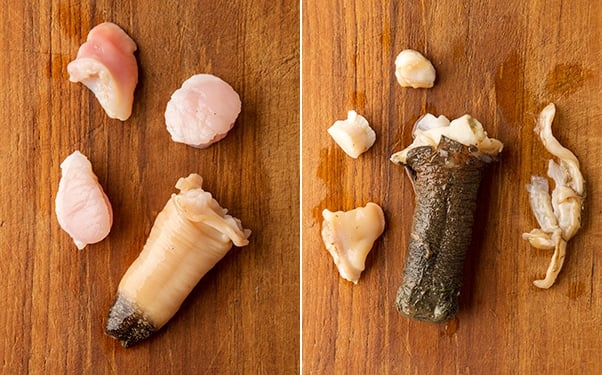
The last thing you must do with the clam meats is clean the bellies. Doing this is the nastiest part of cleaning clams, so nasty that some people discard the bellies altogether. I rarely do this.
To clean the bellies, find the muscular foot and look opposite to it: You will see a dark splotch on a soft, bag-like thing. Squeeze the belly to extrude the black ick from within the belly. When you do this, you will see a hideous, glasslike “pen” shoot out of the belly — it is alarming until you get used to it. Discard this. Run the opened belly under clean running water and use your fingernail to scrape out most of the black stuff.
Your clams are ready to chop or grind now. You can’t really eat gaper clams whole like littlenecks — they’re just too chewy. I grind mine for clam cakes or clam chowder, but many people chop them by hand. Either is fine.
As for the siphons, in the case of horseneck clams, you need to blanch them in boiling water. I boil for 30 to 60 seconds, then plunge the siphons into a bowl of ice water. Slice off the horny end of the siphon and discard. The skin should peel off pretty easily, revealing light colored clam meat with a pretty magenta tip.

You can chop or grind the siphons with the rest of the clam, or you can pound them thin between pieces of plastic wrap and slice for sushi or ceviche or stir fries. Keep in mind that all but the youngest of horse clams will have very tough meat, so don’t skip the pounding step unless you are able to slice it so thin it’s translucent.
Once cleaned, I keep my clam bits in the clam juice, which is salty and will help keep everything fresh. They’ll keep in the fridge for a couple days, but you should freeze them after that. When you freeze, leave at least 1 inch of head space in the jars because the water will expand when it freezes. Frozen like this, the clams will keep a year.
Got it? Great! Now watch this video of me cleaning clams. It should firm up everything for you.

